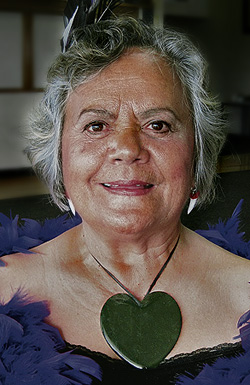Footnotes1. Hikurangi - a 1754 metre peak near the East Cape, and the North Island's highest non-volcanic peak. 2. Raukura - these are literally the rare and beautiful tail feathers of the white heron. The meaning of the word has been extended to anything that is treasured for its beauty, uniqueness and cultural value. 3. Po - literally "darkness." But events from long ago have now receded into the darkness of our memory. 4. Aroha mai - literally "give me love." Used when you accidentally offend someone. "Sorry, forgive me." 5. Huataukina - literally "abundance of strings of sea urchins." When your tribe could collect those, there were also many other kai-moana available too, so you were living in prosperous times. 6. Maui - The Ngati Porou people are descended from a historical Maui who sailed from the Society Islands in the Nukutaimemeha and reached Aotearoa/New Zealand. This Maui seems to have been the man who solved the technical difficultes of cold climate sailing. See below. 7. Nukutaimemeha - Maui's voyaging craft. When cloud surrounds the flanks of Hikurangi but not its peak, your imagination lets you see Nukutaimemeha sailing on top of the clouds. 8. Ki mua - And you also see Maui's crew looking towards the bow. They are reminding you to let go of regrets about lost opportunities in the past, and make the most of what is on offer in the future. 9. Tairawhiti - tai (seacoast) ra (sun) whiti (crosses over). "The coast where the sun rises over the horizon," ie the East Coast. 10. Papapounamu - Papa (flat surface) pounamu (greenstone). "As smooth and glistening as a polished greenstone." 11. Karohirohi - ka-rohi-rohi. Rohi = tear-drops. When grass is covered with dewdrops at dawn, it glistens. Hence, karohirohi - glistening. 12. Te mana motuhake o Porourangi e - Literally "The independant authority of Porourangi," This is a shout similar to the Englishman's "Long live the Queen!" Porourangi was the descendant of Maui who united all those on the East Coast one people, Ngati Porou. Metaphorical storytellingIn the era before stories were attached to words on paper, many cultures attached stories to local physical features. Thus at Mt Sodom in Israel you can still see the pillar of salt Lot's wife was turned into when she looked back, a story telling us to turn away from evil. Kuini has emphasised that story telling is an important aspect in our lives that we need to rekindle. "It is trying to keep in sync with everything that's been created," she told a Sounz reporter in 2007. "It's that kind of relationship. It is not just the spoken language but the body language and it is really important for me to express this through dance and song and chants. That's how it was kept – by just doing it. I feel connected and as one with the universe." Maui's triumph of navigationThe navigator of the Nukutaimemeha, probably dubbed Maui after the mythical explorer Maui-i-tikitiki, seems to have been the man who solved the technical difficultes of cold climate sailing. For centuries, every navigator in the tropical Pacific islands knew there must be a huge land to their south-west because they saw thousands of whales and millions of birds migrating towards it every spring. But when they tried to sail in that direction, the navigators would have encountered chilling rain and hypothermia-inducing southerly winds. The problem was probably solved by departing in mid-summer, developing warm cloaks and waterproof capes, growing long body hair, and learning how to navigate out of rain-squalls and into sunshine. A 15th century boat-hauling chant praises the sea captain who did the last two of these. "Tenei te tangata puhuruhuru, nana i tiki mai whakawhiti te ra!"(Anne Salmond, Hui, page 163)
|
